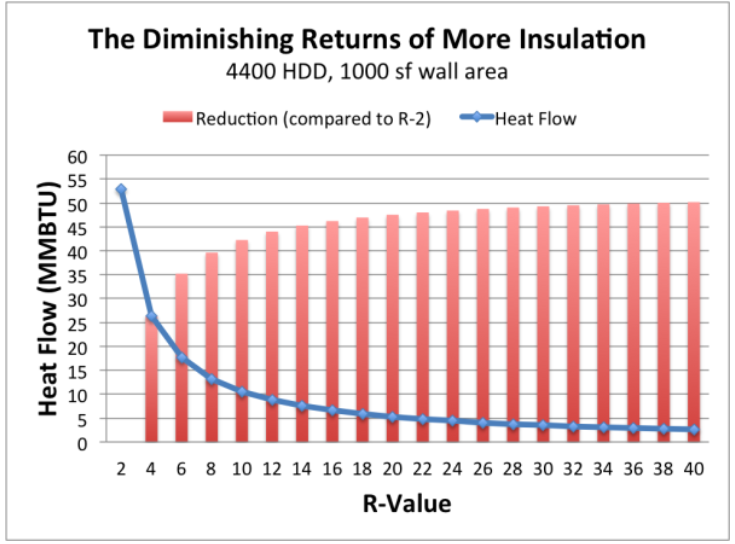As we’ve written about before, there are major issues with only using R-Value to assess insulation and your overall thermal envelope. In this post, we’ll dive into the idea of Diminishing Returns of R-Value because there is misinformation and confusion about how R-Value actually works.
To recap, R-value measures an insulating material’s capacity to resist heat flow. Higher R-value means more resistance to heat flow. It’s a standard number that we all use to compare insulation and it’s a common part of building code. Insulation manufacturers will state a product’s overall R-Value. For example, our 3.5in batts are R13 (R-Value of 3.6 per inch).
Why More Insulation Isn’t Necessarily Better
R-Value is a stackable number which means we can add up R-Values to arrive at a total R-Value for a wall assembly. This is a helpful characteristic of R-Value but it leads to the common misconception that increases in R-Value lead to proportional reductions in heat flow. This is not true. There are diminishing returns when you add more insulation. For example, an R40 wall does not resist twice the amount of heat flow as an R20 wall.
The graph below taken from Energy Vanguard displays the relationship between R-Value and Heat Flow nicely :

Notice what you see here. The reduction in heat flow (blue line) is massive when you go from R2 to R4 to R6 but this reduction slowly flattens out as you add more R Value. It’s way less compelling to add some more R-Value to an R30 wall than it is to an R4 wall. Put another way, insulating an uninsulated wall should always be your first step in the insulation process. And finally, we include some analysis from a recent JLC article that states :
“….if we go from standard cavity insulation in a 2×4 wall (R-11) to a 2×6 wall (R-19), we do gain 42% more R-value (an increase of R-8). But many, even those who work in the building industry, assume that we get 42% greater resistance to heat flow, which is false. The 2×6 wall slows heat flow by only 4% more than the 2×4 wall.”
The Key Question Remains – How much R-Value Do I Need?
Well, it depends. There is no single answer as the variables across projects and climate zones are different. Start with building code and assess from there how far (or if) you should exceed code. If simply saving money is your goal, then your heating and cooling system is a crucial variable. An upgrade to a more efficient system may yield more savings over the long term than adding more insulation. Carbon emission concerns can be addressed similarly. Heat pumps use way less energy than a traditional gas or oil burner. Of course, these carry significant upfront costs but when modeled out over years, the economics can be attractive.
We would be remiss if we didn’t address two topics within the thermal envelope conversation – air tightness and thermal bridging. Insulation won’t do much good if it’s in a leaky wall or one with significant thermal bridges. So always manage as best as possible for air tightness (See our article here) and reduce thermal bridges as they can create tremendous heat flow. Best practice here includes some kind of external rigid insulation, advanced framing techniques and/or construction designed to eliminate TB’s.

Love this! This aspect of insulation doesn’t get discussed nearly enough. Thanks for spreading the knowledge Havelock!
Ditto Ray T’s statement! There’s a lot of chaff and smoke tossed in the air about R ratings and this excellent chart does a terrific job of showing the “heat capture cost/R unit” in a very clear and logical way. Huge kudos to Havelock. I knew there was a reason I love you folks! Keep up the good work!